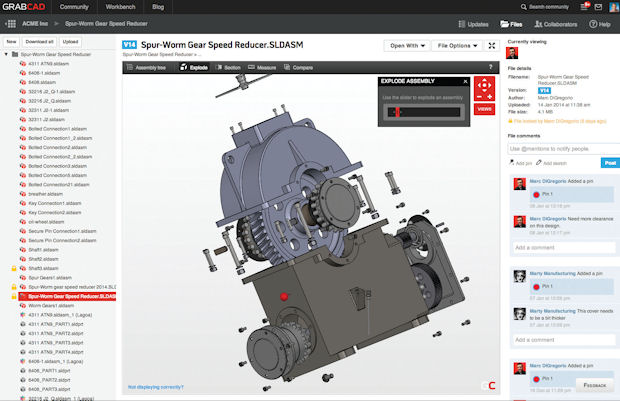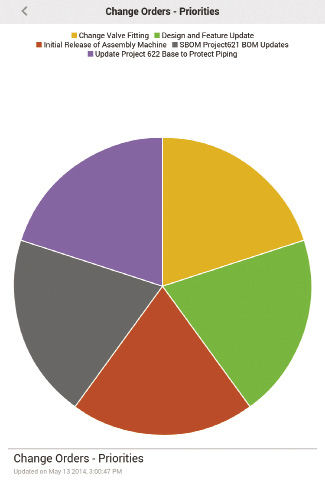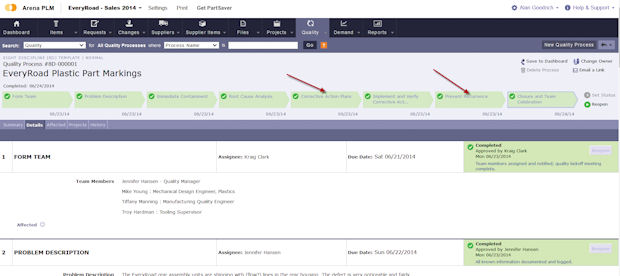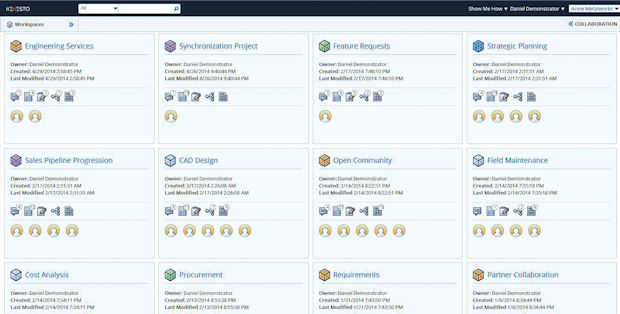
PDM Workbench leverages the cloud to make it easy for designers and engineers to manage and share files. Image courtesy of GrabCAD.
Latest News
September 1, 2014
p>
 PLM in the cloud helps Zep Solar gain tighter control over its change processes, while accommodating its rapid growth. Image courtesy of Affinity Solar via Zep Solar.
PLM in the cloud helps Zep Solar gain tighter control over its change processes, while accommodating its rapid growth. Image courtesy of Affinity Solar via Zep Solar.The cloud has leveled the playing field for companies to gain access to large enterprise-class business software. But it’s just starting to become aggressively touted as a way to put product lifecycle management (PLM) functionality into the hands of small and medium businesses (SMBs), too.
For the better part of two decades, PLM platforms have become widely entrenched in the engineering organizations of the leading aerospace giants, and by top-tier suppliers in the automotive supply chain, among other industries. The traditional, monolithic on-premise PLM system has been much slower to gain ground, however, in small- and mid-sized engineering businesses, which have had trouble digesting the technology because of its relative high cost and complexity.
 A new family of Autodesk PLM 360 mobile apps provides anytime, anywhere access to PLM data. Image courtesy of Autodesk.
A new family of Autodesk PLM 360 mobile apps provides anytime, anywhere access to PLM data. Image courtesy of Autodesk.Like most traditional enterprise platforms, PLM requires a significant investment in software licenses, server and network infrastructure, consulting services, and IT resources to deploy, support and maintain the system. By contrast, cloud applications can be accessed with only a browser and basic Internet connection. Most are offered with a flexible utility-like licensing model, in which users pay a monthly, per-user fee that can easily grow or shrink depending on usage needs.
While the Software-as-a-Service (SaaS) or utility-based model was a near instant hit for enterprise systems like customer relationship management (CRM) and enterprise resource planning (ERP), PLM vendors have generally been slower to embrace the new delivery model. That’s in no small part due to users’ ongoing concerns about the security of design intellectual property (IP) in the cloud—and to a lesser extent, performance. But as comfort with the cloud increases and these worries dissipate, a new generation of SaaS solutions may finally be making PLM functionality accessible to other businesses, which have been handling design collaboration and engineering change orders (ECOs) armed primarily with spreadsheets and manual processes.
“Something like two-thirds of all engineering or CAD users don’t have file management capabilities, because the solutions out there are too hard to use, too expensive and offer too much,” notes Rob Stevens, VP of marketing and business development for GrabCAD, an online 3D content community, which recently introduced Workbench, a cloud-based product data management (PDM) capability. “The next big thing happening in PLM is cloud-based solutions because of the accessibility of the solutions.”
Enabling Core Design Processes
Major vendors in the PLM space, including PTC, Siemens PLM Software, and Dassault Systemes, are still experimenting with how to mash up their respective PLM platforms with the promise of the cloud. For the most part, they’re offering their customers—typically larger enterprises—the ability to run traditional PLM in a hosted environment, or what some might call a “private cloud.” It’s the newcomers like GrabCAD, and PLM late bloomers like Autodesk, that are adopting a true SaaS multi-tenant model. They’re offering functionality that addresses core PLM business processes like collaboration and ECOs without necessary dubbing it PLM.
That’s exactly the strategy of Kenesto, which released its cloud platform for collaborative project execution aimed squarely at SMB customers in 2012. While Kenesto can be used to facilitate non-engineering tasks, one of its sweet spots is design collaboration and engineering changes. The cloud is the linchpin for making these capabilities attractive to the SMB audience, according to Steve Bodnar, Kenesto’s senior VP of product and go-to-market strategy.
“There’s no doubt that traditional PDM and PLM products offer functionality that companies need, but the one thing we’ve always challenged is whether those products deliver that functionality in a way that really makes sense,” he says. “Engineers hate PDM products because they create a level of bureaucracy that engineers don’t see as necessary, and are more about locking data down than facilitating business processes.”
Bodnar points out that modern-day collaboration includes working with key partners, suppliers and customers that reside outside of a company’s four walls—well beyond the jurisdiction of their networks and firewalls. That’s where the cloud comes in.
 Arena has extended its pioneering cloud PLM offering with Arena Quality, which directly connects quality processes to the product record. Image courtesy of Arena Solutions.
Arena has extended its pioneering cloud PLM offering with Arena Quality, which directly connects quality processes to the product record. Image courtesy of Arena Solutions.“Products installed in the cloud are not limited, so you can engage more participants in the product lifecycle, whether that’s in early concept through to design and engineering,” Bodnar explains.
While Kenesto can be tapped to facilitate design collaboration, it handles things differently than traditional on-premise data management platforms like PDM or PLM, he adds. For example, Kenesto doesn’t have explicit check-in and -out commands like PDM/PLM does, yet it still lets design teams access, modify and review key documents without errors or overrides, thanks to intelligent syncing capabilities.
“We think check-in/check-out are relics of the old way of doing things,” Bodnar says. “By automating things, we can deduce what the user is trying to accomplish, and eliminate extra work and system-level bureaucracy that doesn’t need to be there.”
Autodesk, which came late to the PLM game with the February 2012 launch of PLM 360, contends the cloud delivery model is crucial for smaller companies that face the same challenges as larger firms, but are not equipped to handle PLM or have a negative perception of traditional PLM platforms. That’s according to Ron Locklin, Autodesk’s director of PLM 360.
“We’re seeing a lot of smaller customers grapple with the same business challenges as larger enterprises, as far as distributed supply chains, offshore manufacturing and multiple design facilities,” he continues. “Cloud-based PLM makes it that much easier for companies to solve those business challenges.”
GrabCAD’s Stevens also sees the cloud as a way to remove the complexity from PDM and PLM systems and democratize core file management capabilities for more users. That’s the idea behind Workbench, which manages project files in one secure location, provides file management capabilities from inside leading CAD systems, and can be accessed on-the-go from a mobile device, he says.
“The cloud is a great solution because it’s all about collaboration, and the cloud makes it easy for everyone to get to data,” Stevens adds. “Workbench makes it easy to share files with vendors without getting IT involved, and with a strong security model. Stakeholders can be integrated into the project on Day One, accessing the right version of a file and seeing comments from team members. That’s almost impossible with a traditional PLM system.”
Security Becoming a Non-issue
Historically the biggest hurdle to cloud PLM adoption, security no longer seems to be a pressing concern. SMBs and large organizations alike are becoming comfortable with the idea of storing critical data assets in the cloud. Arena, considered the pioneer of cloud-based PLM, is hearing less about security as an obstacle and seeing more interest among potential customers in identifying the core benefits of a cloud-based solution, according to Steve Chalgren, VP of the firm’s product management and strategy.
 Kenesto lets users organize, collaborate and work with others within Project Workspaces that can be created around a project, customer, process or group. Image courtesy of Kenesto.
Kenesto lets users organize, collaborate and work with others within Project Workspaces that can be created around a project, customer, process or group. Image courtesy of Kenesto.“Now the barriers are use case and functionality as compared to competitors,” he says. In fact, he says security has almost become an advantage for the cloud: “The money we spend on security, from firewalls to multiple backup and failovers spread across tens of thousands of users—SMB companies don’t have the IT budgets to handle that.”
What also resonates with users are the other advantages of a cloud-based PLM, from scalability—they can grow or reduce the number of subscriptions as required and only pay for what’s in use—to easy integration with other business systems, to substantial cost savings, Chalgren says.
Not only does cloud PLM spare companies from having to invest in costly on-premise PLM software licenses, maintenance fees, customizations and hardware infrastructure, they can channel those savings to fund new business opportunities, Chalgren points out.
 PDM Workbench leverages the cloud to make it easy for designers and engineers to manage and share files. Image courtesy of GrabCAD.
PDM Workbench leverages the cloud to make it easy for designers and engineers to manage and share files. Image courtesy of GrabCAD.“Cloud PLM frees up capital that can be invested into engineering new products in a company’s domain expertise, rather than spending it on IT,” he adds.
While it’s easy to see SMBs as a likely target for cloud PLM, Aras Software also sees large global companies as good candidates—thanks to the significant cost involved in building out an infrastructure that could support tens of thousands of dispersed users.
“Think about global companies with 10,000 PLM users, 2,000 on each continent,” says Aras President Peter Schroer. “That’s a difficult IT data center to put together.”
Unlike SMBs, which are gravitating to multi-tenant, SaaS cloud PLM solutions, these larger firms are looking at partners like Aras to host their PLM platform in a private cloud, he explains.
While cloud PLM’s value proposition is strong, there are some caveats—particularly as they relate to cost savings. As companies add users to the cloud PLM system, costs grow. Experts say there can be a point where it’s actually more cost-effective to bring the system on premises. Also, heavily customized PLM implementations are not well suited to the SaaS model, and experts caution potential customers to be diligent about their contracts, making sure there is an exit strategy for getting data out of the cloud if they choose to go with another cloud PLM provider or their own on-premise system.
According to Ty Hudson, VP of product development for Zep Solar—which is on its second deployment of PLM in the cloud—the cost, expandability, and data accessibility benefits of this approach far outweigh any of the drawbacks. The firm, which manufactures hardware for mounting solar panels to rooftops, is now using Autodesk PLM 360 to facilitate collaboration, provide a single source of information for its expanding team, and gain tighter control over its engineering change processes.
As a startup with limited resources, cloud-based services were essential for helping to control costs and allow rapid scaling, Hudson points out.
“The cloud deployment model allowed us to rapidly scale our user base as the company grew, benefit from system improvements from Autodesk, and easily roll out our own specific tenant enhancements in real time,” he continues. “New employees can get up and running immediately, whether they are based locally or overseas in our manufacturing group.”
Choosing between cloud and on-premise PLM comes down to how comfortable a business is operating online, Hudson concludes. For Zep Solar, the decision to go with cloud PLM was clear as day. Companies large and small may come to a similar conclusion when exploring the benefits of cloud-based PLM.
More Info
Subscribe to our FREE magazine, FREE email newsletters or both!
Latest News
About the Author
Beth Stackpole is a contributing editor to Digital Engineering. Send e-mail about this article to [email protected].
Follow DE





